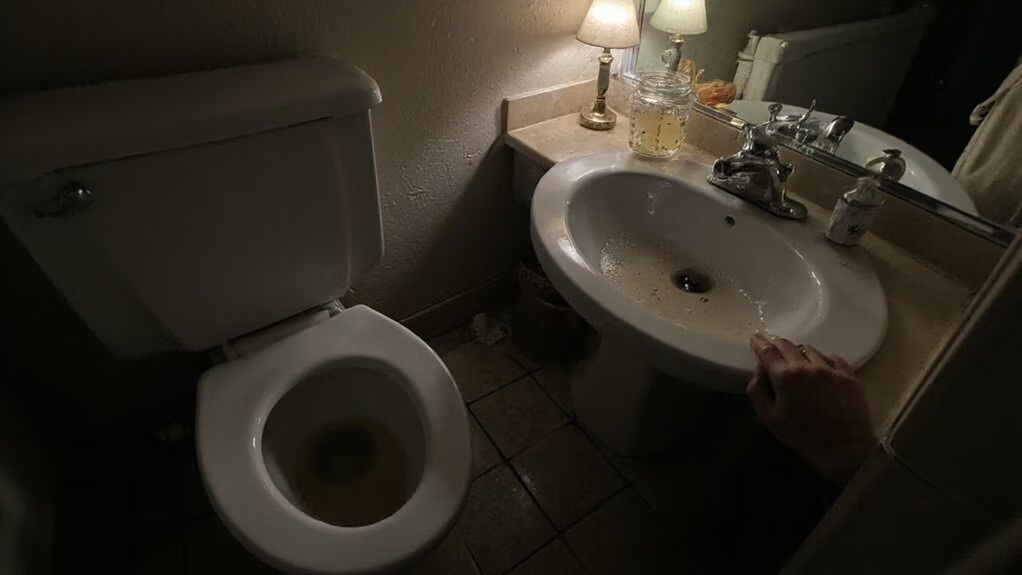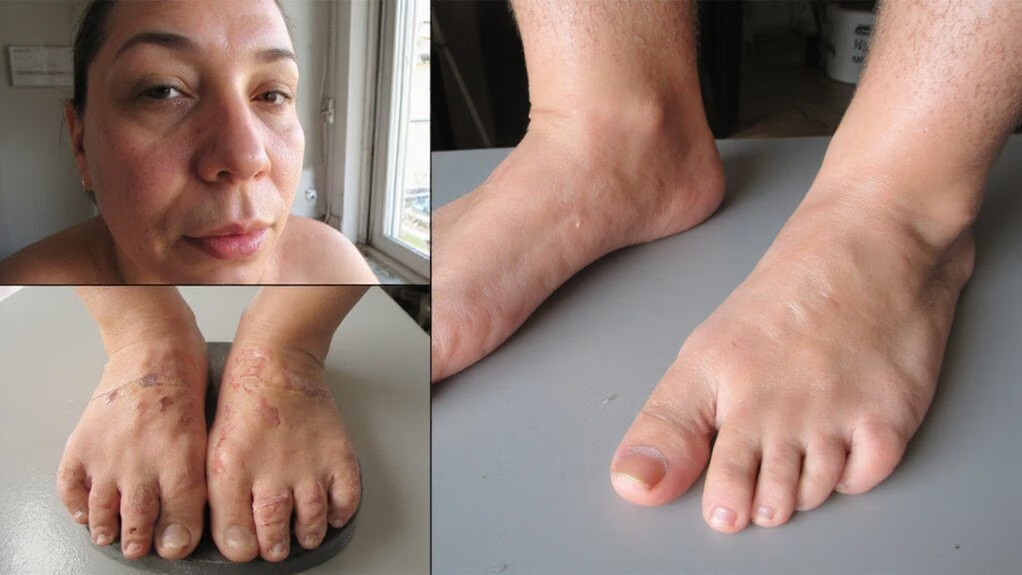You’re likely to notice subtle changes—more or less urination, waking at night, foamy or dark urine, or blood in the stream—and you may feel persistent fatigue, swelling in your feet or around your eyes, or dull flank pain with nausea. These signs often warrant simple tests; here’s what to watch for and when to get tested.
Changes in Urination Patterns

Often, changes in how often, how much, or what your urine looks like signal kidney stress or disease. You should note increases or decreases in frequency, nighttime urination, markedly reduced output, dark or tea‑colored urine, visible blood, persistent foamy appearance, sudden urgency or pain with urination. These findings can reflect glomerular injury, tubular dysfunction, obstruction, or infection. You shouldn’t ignore new patterns; document timing, volume, associated symptoms, and medications. Clinicians rely on urinalysis, urine albumin‑to‑creatinine ratio, serum creatinine with eGFR, and targeted imaging to differentiate causes. Emerging point‑of‑care assays and remote monitoring devices can enhance early detection. Discuss your observations promptly with a clinician so you can pursue timely diagnostics and tailored management that preserve kidney function and reduce long‑term complications collaboratively with clinicians
Persistent Fatigue and Weakness

If you’ve noticed altered urination, you may also feel persistent fatigue and generalized weakness that don’t improve with rest. These symptoms often reflect reduced renal clearance leading to accumulation of uremic toxins and anemia of chronic disease; both lower cellular energy and oxygen delivery. You may report decreased exercise tolerance, cognitive slowing, and morning lethargy. Objective evaluation includes hemoglobin, serum creatinine, estimated GFR, electrolytes, and markers of inflammation; consider screening for iron deficiency and B12. Management targets reversible contributors: optimize anemia using iron or erythropoiesis-stimulating agents when indicated, correct metabolic derangements, and adjust medications that impair mitochondrial function. Track symptom burden with graded activity metrics and validated fatigue scales to guide individualized, innovative care plans and timely nephrology referral for monitoring and outcome evaluation.
Swelling in Hands, Feet, or Around the Eyes

When fluid-regulating kidneys fail to excrete sodium and water efficiently, you’ll notice swelling in your hands, feet, or around your eyes from interstitial fluid accumulation and increased hydrostatic pressure. This peripheral and periorbital edema reflects impaired glomerular filtration or protein loss altering oncotic forces. You may observe pitting over shins or tightness in rings and shoes; morning periorbital puffiness is common. Quantify changes by daily weights and limb circumferences; document timing, symmetry, and associated symptoms like dyspnea. Diagnostic evaluation includes serum creatinine, albumin, electrolytes, urinalysis, and imaging as indicated. Management targets the underlying renal dysfunction while using evidence-based measures: sodium restriction, diuretic titration, and careful fluid management. Expect iterative, data-driven treatment adjustments.
Foamy, Bloody, or Unusually Dark Urine
Because changes in urine color or character can signal significant renal or urinary tract disease, you should report foamy, bloody, or unusually dark urine promptly. Foamy urine may indicate proteinuria from glomerular injury; quantify with a urine dipstick and spot urine protein-to-creatinine ratio. Visible blood (hematuria) warrants urinalysis, microscopy, and prompt imaging or cystoscopy depending on risk factors and age. Dark brown urine can reflect hemoglobinuria, myoglobinuria, concentrated urine, or bilirubin — differentiate with serum creatinine, liver tests, and CK. Document onset, associated symptoms (fever, dysuria, frequency), medications, and recent exercise or trauma. Early testing helps preserve kidney function and guide targeted therapies. Arrange diagnostic testing within 24–72 hours.
Lower Back or Flank Pain
You may feel pain low in your back beneath the ribs on either side (the flanks) rather than centered over the spine. The pain can be a constant dull ache or sharp, colicky spasms that come in waves and may relate to movement or changes in urination. You should seek urgent care if the pain is severe or sudden, comes with fever, nausea, vomiting, blood in the urine, or doesn’t improve within 48 hours.
Typical Pain Location
Often people describe kidney pain as a deep, steady ache or pressure in the flank—the area between the lower ribs and the top of the pelvis—rather than the midline low back pain from spine or muscle. You’ll usually feel it on one side, under the rib cage posteriorly, and it can radiate toward the groin with ureteral involvement, but not into the central lumbar spine. Clinically, flank localization helps distinguish renal causes from musculoskeletal or sacroiliac pain. On exam, tenderness to percussion over the costovertebral angle supports a renal source. Imaging and point-of-care ultrasound can confirm location and laterality quickly, guiding targeted diagnostics and interventions. Apply these findings to streamline your diagnostic decisions.
Pain Quality and Timing
When evaluating lower back or flank pain, note the onset, duration, and temporal pattern—sudden, severe colicky pain that comes in waves and radiates to the groin strongly suggests ureteral obstruction (stone), whereas a constant, dull ache with fever or urinary symptoms points toward pyelonephritis or another renal inflammatory process. You should characterize intensity, triggers, alleviating factors, and associated features (nausea, hematuria, dysuria) because they refine differential diagnosis and imaging strategy. Temporal details guide severity assessment: paroxysms favor obstruction, progressive constant pain with systemic signs favors infection or inflammation. For innovation-minded patients, think of pain patterns as diagnostic signals that pair with point-of-care ultrasound and lab algorithms to prioritize tests.
- Sharp, wave-like pain shooting to groin
- Persistent, deep ache with fever
- Pain eased by movement
When to Seek Care
If pain is sudden, severe, or comes with fever, vomiting, fainting, or inability to pass urine, seek emergency care right away. You may be experiencing obstructive uropathy, pyelonephritis, or renal colic; time-sensitive interventions can prevent renal injury and sepsis. If pain is persistent, worsening, radiates to groin, or you have blood in urine, contact your clinician promptly for urgent assessment, imaging, and laboratory testing.
If pain is mild, intermittent, and isolated without systemic features, arrange timely outpatient evaluation within 48 to 72 hours to assess for kidney stones, musculoskeletal causes, or referred pain. Use telehealth or rapid-access clinics for triage; bring symptom timelines, medications, and relevant history. Early, data-driven evaluation improves diagnostic accuracy and outcomes. Consider novel diagnostics and wearable monitoring when available widely.
Nausea, Loss of Appetite, or Metallic Taste
Because failing kidneys can’t clear uremic toxins and inflammatory mediators, you may develop persistent nausea, reduced appetite, or a metallic taste in the mouth. These symptoms reflect toxin accumulation and inflammation altering gut motility, chemosensory receptors, and gastric emptying; they correlate with rising BUN/creatinine and inflammatory markers. You should report new symptoms to your nephrology team; adjustments in dialysis, dietary counseling, or targeted antiemetics can improve nutrition and quality of life. Consider diagnostic steps: review labs, assess medication effects, and screen for reversible causes. Emerging interventions—precision nutrition, taste-modifying agents, and microbiome-directed therapies—are under study to restore appetite and reduce symptoms.
- dry, persistent sour taste that turns food unappealing
- early satiety and weight decline despite unchanged intake
- nausea that worsens before dialysis or with medications
Conclusion
If you notice changes in urination, persistent fatigue, swelling, foamy/dark/bloody urine, flank pain, nausea, or appetite loss, document timing and associated symptoms and contact your clinician promptly. Early testing (urinalysis, serum creatinine/eGFR, renal imaging when indicated) helps identify reversible causes and guide treatment. You’ll likely need medication review and targeted interventions; timely evaluation reduces complications and improves outcomes. Don’t delay seeking care—early diagnosis matters. Bring a symptom diary and current medication list to appointments, please.